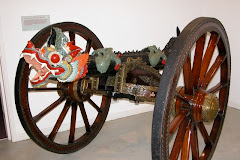For most of the period known as the Middle Ages and onwards into the 20th Century, sieges have been a recognized and regular form of warfare. Whether the defenders were in a traditional castle or walled town, or simply holding a piece of territory with strong defences, the process of attacking is known as a 'siege'. I will use the term 'fortress' throughout for the sake of keeping it simple.
In this piece, I will deal with sieges typical of the period 1600-1850, but the principles can be extended over a wider period.
Sieges were usually undertaken in the course of a campaign in another country or during a civil war, when the attacking army needed to make progress but was loth to leave a defended fortress in its rear. There was always the danger of defenders in these places sallying forth to attack the army's lines of communication. The answer was to 'lay siege' to the fortress and capture it.
This was a specialized form of battle. The procedure followed a fairly set pattern, predictable to such an extent that, by the time of the Peninsular War, it was possible to say that a given fortress could only hold out for about 40 days. Attackers needed to get the attack over before any other force could come to the relief of the defenders, and the commander of the attacking force had to take into account the possibility of coming under attack himself.
The first move would be to throw a ring around the fortress, preventing anyone from getting out as well as holding off any relief attempts. Next came the process of capturing any out-works - key places in the outer defences that were designed to make it difficut to attack the main fortress. To breach the defences themselves - usually a system of high walls and ditches, designed by experts in fortification - it was a question of getting guns close enough to the chosen point of attack to be effective. They had to make a hole wide enough for the infantry to pour through and attack the defences directly.
The hitting power of a cannonball falls as range increases, simply because it loses speed due mainly to air resistance. Thus the closer the guns could get to the walls, the more damage they could do and the faster they would force a breach in the walls. But the fortress was usually well equipped with guns of its own and these were often bigger guns than those of the besieging force because they were not having to be moved about on the campaign. The attackers therefore had to work their way forward carefully to avoid the guns being destroyed by 'counter-battery' fire.
They did this by digging long trenches, or saps, that aligned diagonally forward at an angle that prevented the defenders from looking along them and seeing what was going on. Men and materials were moved forward to positions that were often developed during the hours of darkness, where guns could be emplaced on firm platforms with protection in the form of gabions. A gabion was a large wickerwork basket filled with earth or stones - these were often made using local labour. These would be stacked up on the front of the firing platform with gaps through which the guns could fire. A gabion could in fact be anything that would absorb the power of incoming shot and there is an account of one siege where the attackers found a warehouse full of baled sheeps' wool, and used these to good effect.
Woolsacks as gabions
There would often be two or three new firing positions as the batteries moved closer until they were as little as 200 yards from the walls, from which distance they could cause enormous damage, although it could also mean they were in greater danger themselves from the defenders' firepower. In addition, there would be attacks at different points on the walls to keep the defenders guessing as to the intended main attack.
Neutralizing the defenders' guns was important for obvious reasons and this was the task of field batteries, often equipped with howitzers and mortars at longer ranges. Their role was to bring fire down on the fortress's guns and on defenders who might be trying to reinforce their positions behind the expected point of breaching.
It seems remarkable, but the breaching batteries could quite accurately 'cut' a wall, literally carving out a section with vertical 'cuts' of the width they required for a breach and then cutting a line across the bottom of the section so that the whole wall slid to the ground - more often into the ditch that usually surrounded the walls. This not only got rid of the wall, but also provided a means of filling the ditch and making it a bit easier to cross.
Thursday, 15 October 2009
Subscribe to:
Posts (Atom)




